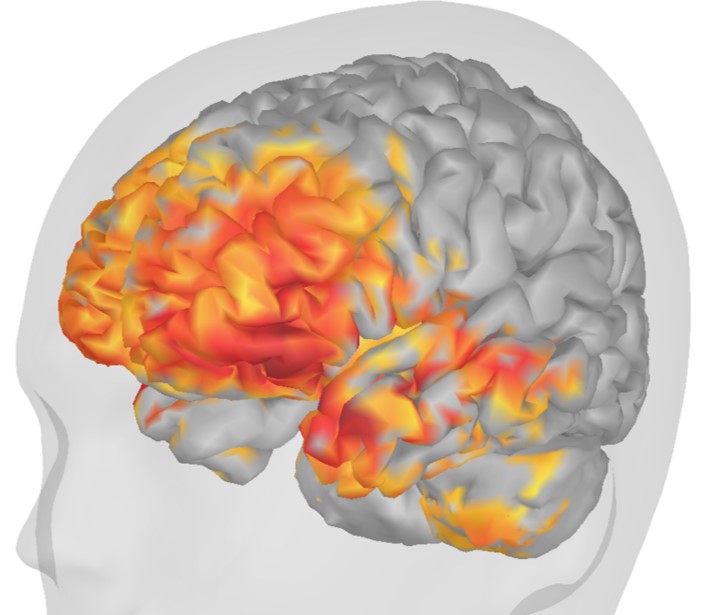Brain wave readings may be key to detecting concussions
Delta waves, which normally fade as kids get older, spiked in concussed high school athletes
DALLAS – Oct. 25, 2022 – Measuring levels of a specific brain wave could lead to more objective, definitive methods of diagnosing concussions and determining when young athletes can safely return to play, according to a UT Southwestern study.
The research shows that delta waves – which decrease with age and are typically only present in adulthood in cases of disease or head injury – increased in high school football players who sustained concussions. In most patients, those levels decreased only after symptoms subsided, according to the study published in Brain and Behavior.

“Because these waves are supposed to fade as teens get older, the findings suggest the spike in delta could be a marker for not only detecting concussion, but also measuring recovery in young athletes,” said study leader Elizabeth Davenport, Ph.D., Assistant Professor of Radiology, Neurology, and the Advanced Imaging Research Center at UT Southwestern. “We are one step closer to providing a clinical service that better informs patients regarding return-to-play decisions.”
Concussions occur when a bump, blow, or jolt to the head causes the head and brain to move back and forth, prompting chemical changes in the brain and sometimes stretching or damaging brain cells. Football is associated with the greatest number of concussions among all sports played in the U.S. These mild yet traumatic brain injuries can cause debilitating symptoms, including headaches, vomiting, and vision changes, as well as long-term cognitive problems, including confusion, lack of concentration, or memory loss.
However, Dr. Davenport explained, diagnosing concussions can be challenging. The neuropsychological testing and symptoms checklists used for diagnosis can be subjective and nonspecific, and studies have shown that up to 78% of players hide their symptoms, increasing the risk of long-term detrimental and even fatal outcomes if they return to play before recovery.

Studies using magnetoencephalography (MEG), a noninvasive type of brain mapping, have shown that adults who sustain concussions produce delta waves – low-frequency brain activity that isn’t typically present during adulthood. But because children have active delta waves that fade before adulthood, it has been unclear if delta waves might be useful for diagnosing concussions in younger patients.
To answer this question, Dr. Davenport, along with colleagues at UT Southwestern and Wake Forest School of Medicine, recruited three groups, each with eight high school athletes: football players who sustained concussions (including quarterback, cornerback, wide receiver, tight end, safety, and line positions); football players matched for age, position, and demographic factors who hadn’t sustained concussions; and athletes from noncontact sports, including swimming and tennis.
The volunteers received a MEG scan at Wake Forest Baptist Health before and after their seasons, as well as an additional scan if they were diagnosed with a concussion during the season. UTSW’s analysis of the collected data showed that delta waves decreased slightly over the season for non-contact sports athletes who didn’t have concussions, as expected during adolescence. However, delta waves increased significantly in the immediate aftermath of a concussion, which remained evident even in the postseason.
Why this occurs is not yet known. But, Dr. Davenport said, evidence from other studies suggests an increase in delta waves is related to a naturally occurring metabolic cleaning mechanism, suggesting this type of brain activity reflects a healing process. Regardless, she added, these findings could eventually offer a way to diagnose concussions in young athletes and potentially show when healing is complete, which could help inform when these patients are ready to return to competition.
While on average, those with a concussion had more delta waves, further studies are needed to determine the accuracy of using delta waves to diagnose individual adolescents’ cases, and more research will be necessary to move this work into clinical practice, Dr. Davenport said. She and her team plan an expanded study of concussed athletes using MEG in the Dallas-Fort Worth area.
Other UTSW researchers who contributed to this study include Jesse C. DeSimone, Ben Wagner, and Joseph A. Maldjian.
Dr. Maldjian holds the Lee R. and Charlene B. Raymond Distinguished Chair in Brain Research.
This study was supported by the National Institutes of Health grants R01NS082453 and R01NS091602.
About UT Southwestern Medical Center
UT Southwestern, one of the nation’s premier academic medical centers, integrates pioneering biomedical research with exceptional clinical care and education. The institution’s faculty has received six Nobel Prizes, and includes 24 members of the National Academy of Sciences, 18 members of the National Academy of Medicine, and 14 Howard Hughes Medical Institute Investigators. The full-time faculty of more than 2,900 is responsible for groundbreaking medical advances and is committed to translating science-driven research quickly to new clinical treatments. UT Southwestern physicians provide care in more than 80 specialties to more than 100,000 hospitalized patients, more than 360,000 emergency room cases, and oversee nearly 4 million outpatient visits a year.
